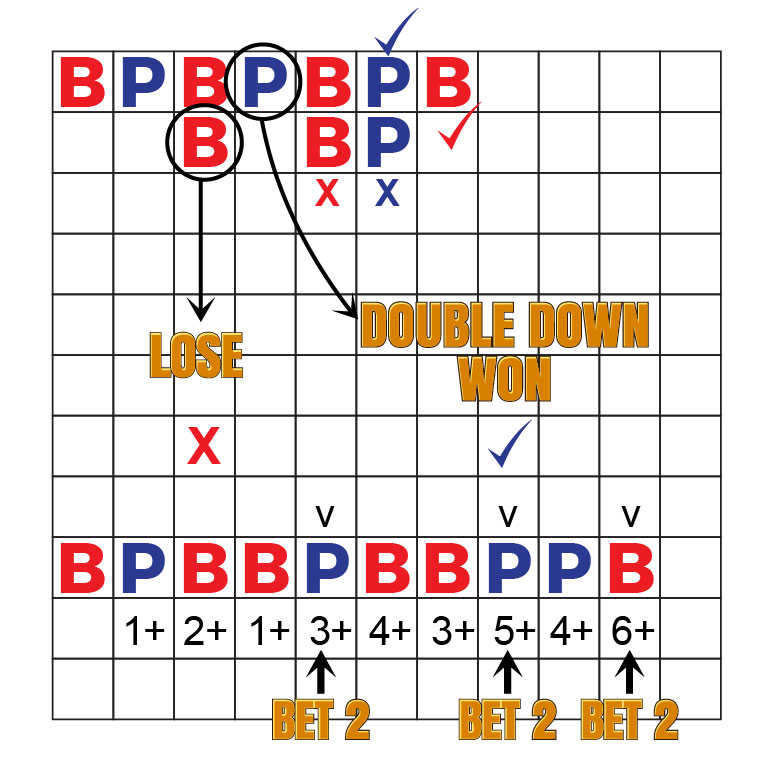- Crystal Classics is the largest independent retailer of Orrefors Crystal in the U.S. As early as 1726, Lars Johan Silversparre received permission to build a furnace and a smithy at 'the beautiful river that flows into Lake Orrenas'.
- Four Kindergartner Cloth set 18 Play Girl Doll shoes Doll wigs Reborn Baby StrawBerina Honee-B Bleuette 12 InMotion Girl NEW ITEMS Ten Ping series Five Doll Series Doll Accessories 14 Play Girl Tanghulu Belinda - 8 15 Girls of the Orient.
- You can do this with almost any method. But the important thing to remember is to be agile enough to stop when it ends. All win streaks end about the same. The perfect pattern just stops or it falls apart in just a few spins. Same goes for Baccarat. I tend to pull back on the first loss unless I'm hammering singles on the weak side.
- Baccarat Pattern Strategy
- Baccarat Pattern Recognition
- Baccarat Pattern Recognition
- Baccarat Pattern Strategy
Baccarat French Art Nouveau Blue Opal Glass Vase. Orrefors 1949 Hald Rare Engraved Snee Farm Vase. Virginian Pattern Pedestal Cake Stand Cambridge. Discover our most popular crystal glassware patterns. Get ready for every guest to raise a glass. Shop double old fashioneds, wine glasses, water goblets, champagne flutes, decanters, and much more from well-known crystal makers like Waterford, Mikasa, Lenox, Gorham, and others.
The Stock Market Crash of 1929, also known as “Black Tuesday,” marked the cataclysmic start of the Great Depression, the largest financial downturn in U.S. history. The widespread impact of the economic disaster led to conservative consumer behavior that lasted the next decade: only shopping for what you could afford, foregoing luxury brands, and abandoning any brand loyalties that existed before the Crash.

Despite the financial strain on consumers and businesses, a few creative glass manufacturers managed to survive by producing affordable glassware and creating effective strategies for distribution. This inexpensive glassware—commonly known as Depression glass—was mass-produced from 1920 to 1950. Today these Depression-era relics are widely collected in the United States.
A Brief History of Depression Glass
Assorted Depression-era glassware, amber. Sold for $46 via Jeffrey S. Evans & Associates (July 2019).
At the turn of the 20th century, hand-crafted glassware was a household staple for wealthy families. Delicate crystal plates and cups were manufactured in small shops called Hand houses, where intricate hand finishes were added to glassware. As the cost to make detailed glassware was high, hand-crafted glassware was considered a luxury item, and was only accessible to the wealthy. During the 1920s, some glassmakers identified a need for affordable glassware to market to working class American families as a way to expand their business. Thus the production of unfinished glassware, offered at accessible price-points, began.
Manufacturing
When the Great Depression began, costly glassware fell out of favor among consumers. Depression glass grew popular among female consumers who sought the aesthetic of expensive place settings for a fraction of the cost. Over twenty manufacturers produced Depression glass from the 1920s to the 1950s, including Jeanette, Hazel Atlas, and Anchor-Hocking.
Distribution
Manufacturers optimized their production processes and were able to sell twelve-piece dinnerware sets for under two dollars. Since the manufacturing of Depression glass was relatively inexpensive, companies began offering Depression glass objects as promotional items. Glass pieces were included in cereal boxes and given away at movie theaters or gas stations to retain loyal customers during the recession. Consumers trying to save money took advantage of these promotions and slowly built complete dinnerware sets by collecting promotional goods over time.
Depression Glass Characteristics
Each manufacturer that produced Depression glass developed favored colors and shapes, as well as signature patterns — with some that were widely sold and some that were created in smaller batches. In the years that followed Depression glass production, many fake or reproduction pieces entered the market, which is why it’s important for collectors to understand the characteristics of authentic Depression glass, and know what to look for.
Assorted Pressed Depression Glass. Sold for $80.50 via Jeffrey S. Evans & Associates (March 2014).
Color
Baccarat Pattern Strategy
Depression glass was produced in virtually every color. Yellow and amber patterns were the popular choice for the era, followed by green, blue, pink, and crystal. Manufacturers created a few patterns in unique hues such as alexandrite and tangerine, which ultimately failed in the marketplace. In today’s market, these unpopular colors are highly sought after by collectors, while the common varieties like yellow and amber have been rendered worthless.
Cameo Depression Glass Soup Bowls. Sold for $190 via Jeffrey S. Evans & Associates (February 2016).
Pattern
During the thirty years of production, over 100 patterns of Depression glass were manufactured. Each company had signature patterns, each of which are worth different amounts in the market today. Some of the most common patterns were Cameo, Mayfair, American Sweetheart, Princess, and Royal Lace. The romantic and idealistic names reflected a societal longing for the prosperity of the 1920s, a time that propagated dreams of a successful life to come.
Depression Glass Bowls With Flower Frog. Sold for AUD20 via Lawsons (September 2018).
Unique Conditions
The speed at which Depression glass was produced, coupled with the quality of its wares, is what ultimately made these pieces affordable. They also lent way to a significant amount of flaws. Imperfections such as bubbles, molding flaws, and inconsistent coloring are prevalent in these pieces; however, they rarely affect the value of the wares. In fact, many collectors even cherish the inconsistencies.
Although opulent glassware was a low priority for the vast majority of Americans who were struggling financially, there were still a select few who could afford high-end glassware. For this segment of the market, high-quality, handmade pieces called Elegant glass were produced. These pieces were often clear, made without imperfections, and featured designs recessed into the glass, rather than offering raised patterns like that of Depression glass.
Tips For Collectors

While many of the common patterns in yellow or amber can be acquired for just a few dollars, patterns that were short-lived during the Great Depression are particularly valuable. Glass that was once worth less than a quarter can be worth thousands of dollars today. Whether you are just starting your collection or have had years of experience, there are a few key tips to keep in mind when buying a new piece.
Assorted Depression-era pressed glass, red. Sold for $128 via Jeffrey S. Evans & Associates (July 2019).
One of the most challenging aspects of collecting Depression glass is finding pieces that aren’t flawed. Since these glasses were made for daily use, many available pieces have years of wear on them. When examining a piece of glassware, keep an eye out for these three common condition issues:
- Cracks, scratches, and chips: A large percentage of Depression glass on the market is riddled with imperfections, which can be hard to spot from initial inspection. For scratches and cracks in the glass, it is best to hold the piece up to the light. To find chips, run your fingers along the edges and base of the glass to make sure it doesn’t have any imperfections.
- Sick glass: One of the common imperfections that Depression glass features is cloudy etching caused by automatic dishwashers. Collectors refer to glass with this problem as “sick glass.” When glass suffers this type of damage, it can’t be restored and significantly decreases in value.
- Water rings: If the glass looks cloudy, look closely to determine if it is sick glass or simply stained with water. The latter can often be fully restored and is worth the investment.
Patterns and Popular Colors
The current collector’s market is directly related to the popularity of certain patterns of glass during the Great Depression. The popular patterns and colors from the 1930s are commonly found in antique stores and auctions across the United States, but are only worth a few dollars. On the other hand, less popular patterns and colors are widely sought after.
Baccarat Pattern Recognition
Five-Piece Depression Glass Wine Set. Sold for $180 via Jeffrey S. Evans & Associates (February 2016).
American Sweetheart (1930–1936)
Macbeth Evans Glass Company, a prolific Depression glass manufacturer, known for their thin and delicate glass, produced a pattern called American Sweetheart that was manufactured from 1930 to 1936. American Sweetheart was produced in large quantities in the color pink. Though these pieces are common, the soft pink tone has made this pattern desirable a century later.
Cameo (1930–1934)
The Cameo pattern was the third most popular line made by Anchor Hocking Glass Company. From 1930 to 1934 it was created in green, yellow, pink, and crystal. Today, while green Cameo pieces are very common and can be purchased for just a few dollars, pink and yellow pieces are very rare due to limited production and can be worth hundreds.
Princess (1931–1934)
Anchor Hocking Glass Company, a giant in the Depression glass industry, created several patterns that were wildly popular. From 1931 to 1934 they created the Princess pattern in pink, green, and topaz. Princess pieces are treasured by collectors for their signature scalloped edges.
Mayfair (1931–1937)
Mayfair was another pattern made by Anchor Hocking Glass Company. This pattern was produced in pink, blue, yellow, and green from 1931 to 1937. In the 1930s, pink was the most popular color of the Mayfair pattern, making it a common find in today’s market. Blue Mayfair pieces, however, are highly sought-after and can be worth several hundred dollars.
Royal Lace (1934–1941)
The most sought after pattern of Depression glass is arguably Royal Lace, which was made by the Hazel-Atlas Glass Company. This pattern was manufactured in green, pink, crystal, and most notably, cobalt blue. This signature blue glass was only produced from 1936 to 1941, making it more valuable than the other colored patterns of Royal Lace.
Reproductions
In recent years, reproductions of Depression glass have been created and sold as antiques, making it difficult to ensure that a piece is authentic. Before you purchase a piece of glass, inspect it closely, paying particular attention to the seams on the glass. Fast production of Depression glass caused some glasses to slip in the mold, causing noticeable seams on the piece. These glasses were also used for daily meals, so authentic glass will feature scratching from knives and other utensils. In general, authentic Depression glass will look imperfect and used; if it looks perfect, it is most likely a reproduction.
Baccarat Pattern Recognition
Depression glass in the market today—despite its imperfections—has withstood 100 years, which speaks to the resiliency and longevity of its charm and appeal. Whether inherited, found, or purchased, collectors value Depression-era pieces today for their historical significance as an innovative solution an bright moment during one of the darkest decades in American history.
More from In Good Taste:
Baccarat Pattern Strategy
Sources: Little Things Dusty Old Thing Romantic Homes Glass Bottle Marks